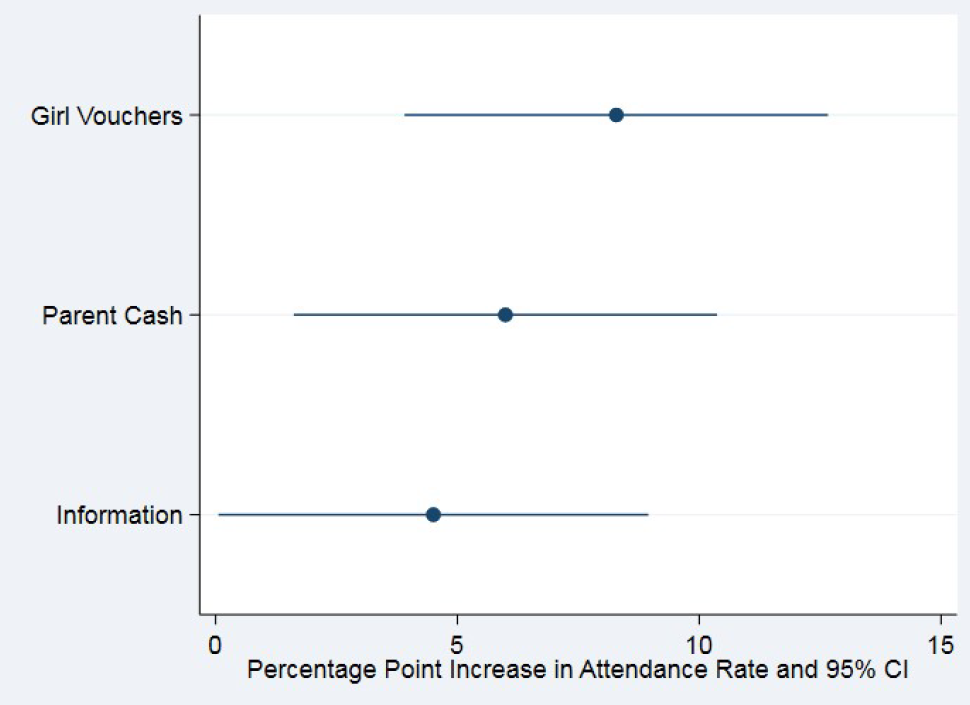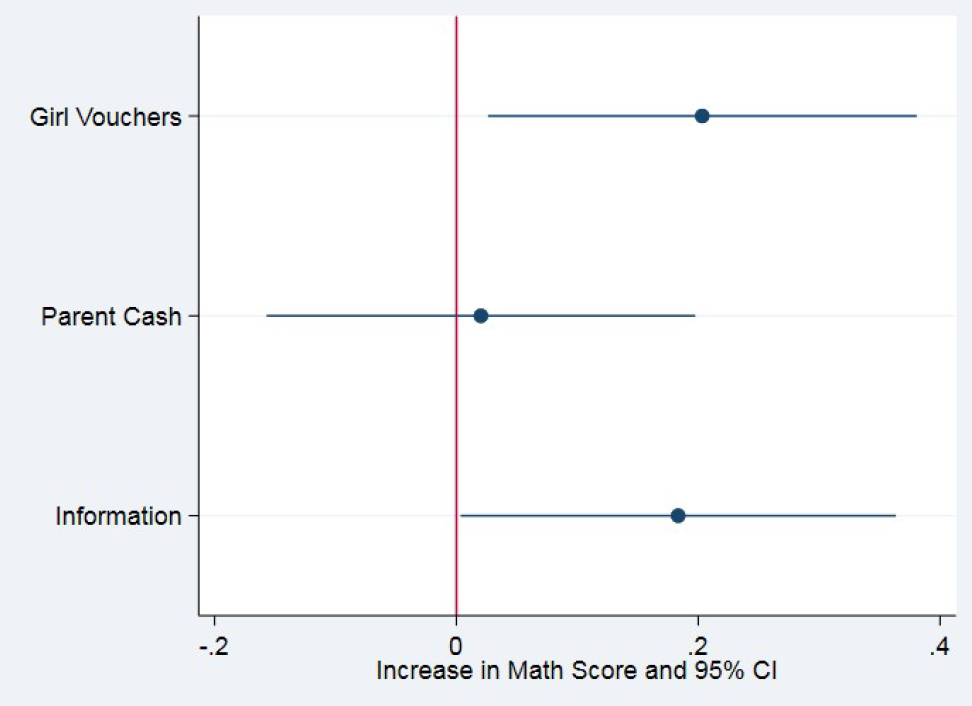
Research in Mozambique highlights new, lower-cost approaches to reducing pupil absenteeism in low-income countries
Pupil absenteeism is a pervasive issue which hinders educational attainment in both developed- and developing countries (Bedi and Marshall 1999, Manacorda 2012, Glewwe et al. 2013, Aucejo and Foy Romano 2016, Robinson et al. 2018). One popular policy tool to improve school attendance in developing countries is the use of conditional cash transfers (CCT), a type of social transfer typically targeted at parents but requiring their children to attend school regularly. CCTs have been implemented in over 60 countries (Parker and Todd 2017) and have been shown to lead to a wide range of positive effects on schooling and other economic and social outcomes (Attanasio et al. 2023, Araujo and Macours 2022). But their implementation costs are also substantial, which has led researchers to study ways in which the design of CCT programmes can be optimised, or some of their impact achieved at a lower cost.
In a recent paper (De Walque and Valente forthcoming), we consider two alternatives to the typical model of incentivising parents with cash, which have the potential to increase school attendance at a lower cost. In doing so, we also shed new light on the relative roles of parents and children in making decisions about school attendance in a low-income setting.
Understanding the role of child agency to devise lower-cost interventions
There are many reasons why pupils may miss school. The focus is most often on the opportunity cost, for poor parents, of sending children to school instead of working on the family farm or carrying out chores such as fetching water and looking after younger siblings to free up parental time. Less often discussed in low-income country settings is the role of children themselves, despite evidence of peer effects in school attendance decisions (reviewed in e.g. Kremer and Holla 2009), and the large share of children who, having dropped out of school by age 15, say in surveys that they themselves played the most important role in deciding to do so. Our calculations based on Young Lives Round 3 data (Boyden 2014) indeed indicate that this share varies between 40% and 80% across India, Ethiopia, Vietnam, and Peru.
When absenteeism is at least in part due to children themselves not wanting to attend school, the conditionality attached to traditional CCTs may not simply work through financial incentives. CCTs may also more subtly impact attendance through an information channel (Bursztyn and Coffman 2012). Indeed, when parents enrolled in a CCT receive the conditional transfer, it also informs them that their child attended school regularly, which can in itself help parents ensure that their children are attending school regularly (if parents do not or cannot otherwise perfectly monitor whether their child is at school).
When children have more information than parents about whether or not they skip school, targeting transfers directly at children should lead, holding all else equal, to a larger increase in attendance per dollar of transfer than targeting transfers to parents, since the latter are less able to enforce child attendance. In addition, it can also be shown that, in this case, simply telling parents whether or not their child skips school may increase attendance even without financial incentives.
A rigorous test of the effectiveness of alternative interventions
We tested the effectiveness of two alternatives to CCTs: incentivising children rather than parents (with a system of vouchers instead of cash), and providing information to parents about their child’s school attendance but no financial reward. We compared these alternative interventions to a more traditional intervention incentivising parents with cash, as well as to a control group. Following the gold standard in establishing causal impacts, we randomised schools into each of the four experimental arms (three intervention arms and one control arm).
This randomised controlled trial (RCT) took place in 173 schools of Mozambique’s Manica Province and involved about 15,000 girls in their two final years of primary schooling. Despite large increases in enrollment rates in lower primary school grades, most Mozambican children, particularly girls, are still not completing primary education. While high teacher absenteeism is a well-known issue across the developing world, the latest evidence from Mozambique indicate that pupil absenteeism is much higher (45.8% pupil absenteeism versus 29.8% teacher absenteeism in 2018, Bassi et al. 2020) and qualitative data collected in our study setting suggested that both parents- and their daughters played a role in pupil absenteeism.
In the intervention arms in which we introduced rewards (either vouchers or cash), transfers were conditional on achieving at least 90% attendance during the school trimester. In the “child incentives” treatment arm, we gave vouchers at the end of each trimester to girls meeting this condition, who could then use the vouchers to buy a selected number of items such as school uniforms, shoes, backpacks, or other smaller materials (e.g. soap, toothpaste, pens, notebooks, etc...). In both transfers arms, the value of the transfers was 400 meticais (US$ 8) per trimester with a maximum of 1,200 meticais over the school year or about 7% of per capita GDP. By using vouchers rather than cash in the child incentives arm, we increased social acceptability and ensured that the girl was the end recipient.
In both conditional transfers arms, the conditionality was enforced by a partner NGO based on the information contained in weekly attendance report cards introduced as part of the intervention. Prior to our trial, only three schools in our study sample systematically reported absences on a weekly basis. The same attendance report card system was implemented in the “information only” arm, but attendance was not incentivised by vouchers or cash transfers. A fourth experimental group constituted the control group.
Overall, we find that these lower-cost alternatives were at least as effective in increasing attendance and improved learning more than the parent incentives.
Effect on attendance
Throughout the intervention school year, we verified pupil attendance through unannounced attendance checks and found that our interventions significantly increased attendance by between 4.5 percentage points (information only intervention) and 8.3 percentage points (parent cash incentive intervention). Strikingly, the effect of the CCT intervention (6 percentage points) was not much larger than that of only providing the information component of the CCT without cash incentives (and statistically indistinguishable from it).
Figure 1

Effect on parental knowledge of child absences
All our interventions improved parental knowledge of their child’s absenteeism. In the control group, there was no correlation between child absenteeism as reported by parents in a survey question and actual absenteeism on an attendance check day. In contrast, in the groups in which we introduced weekly attendance reports either with or without incentives, parental reports were highly correlated with verified absenteeism.
Effect on math scores
Both of our innovative interventions achieved a given decrease in absenteeism at a lower cost than the more standard parental incentives. Reassuringly, this did not come at the price of lower learning gains. In fact, the average effect of our lower-cost interventions on a simple math test is significantly more positive than that of the parental incentives intervention. While the study was not set up to provide a detailed analysis of the impact of the interventions on learning, our exploratory analysis of the math score finding suggests that the difference in learning impacts across intervention groups may be due to a combination of differences in the type of children and parents who responded to the different interventions and to some adverse learning effects of the parental incentives.
Figure 2

Main policy takeaways
Our findings highlight low cost interventions that can increase attendance in low-income settings. More generally, our results give support to the hypothesis that children have agency in decisions concerning their education. Taken together with recent work by, among others, Bergman (2021), Berlinski et al. (2021), Bursztyn and Coffman (2012), and Rogers and Feller (2016) from middle- to high-income country urban study areas, they provide compelling evidence that parent-child information asymmetries exist in a varied range of geographies and can be leveraged to improve educational outcomes at comparatively low cost.
References
Aucejo, E M and T F Romano (2016), "Assessing the Effect of School Days and Absences on Test Score Performance." Economics of Education Review 55: 70-87.
Araujo, M C and K Macours (2022), "The impact of Mexico’s Progresa programme twenty years on", VoxDev.
Attanasio, O, L Cardona Sosa, C Medina, C Meghir, C Posso and B Taboada (2023), "The long-term effects of conditional cash transfer programmes: Evidence from Colombia", VoxDev.
Bassi, M, O Medina and L Nhampossa (2020), “Education Service Delivery in Mozambique: A Second Round of the Service Delivery Indicators Survey”. Unpublished report.
Bedi, A, and J H Marshall (1999), “School attendance and student achievement: Evidence from rural Honduras.” Economic Development and Cultural Change 47(3): 657-682.
Bergman, P (2021), “Parent-Child Information Frictions and Human Capital Investment: Evidence from a field experiment investment.” Journal of Political Economy 129(1): 286-322.
Berlinski, S, M Busso, T Dinkelman and C Martinez A (2021) “Reducing Parent-School Information Gaps and Improving School Outcomes: Evidence from high frequency text messaging in Chile.” NBER Working Paper 28581. VoxDev Article.
Boyden, J (2014), "Young Lives: An International Study of Childhood Poverty: Round 3, 2009. 2nd Edition." UK Data Service. SN: 6853, http://doi.org/10.5255/UKDA-SN-6853-2.
Bursztyn, L and L Coffman (2012), “The Schooling Decision: Family preferences, intergenerational conflict, and moral hazard in the Brazilian favelas.” Journal of Political Economy 120(3): 359-397.
de Walque, D and C Valente (Forthcoming), "Incentivizing School Attendance in the Presence of Parent-Child Information Frictions." American Economic Journal: Economic Policy.
Glewwe, P, E A Hanushek, S D Humpage and R Ravina (2013), "School Resources and Educational Outcomes in Developing Countries: A Review of the Literature from 1990 to 2010." In Glewwe Paul. (ed), Education Policy in Developing Countries. The University of Chicago Press, Chicago.
Kremer, M and A Holla (2009), “Improving Education in the Developing World: What Have We Learned from Randomized Evaluations?” Annual Review of Economics 1: 513-542.
Manacorda, M (2012), “The Costs of Grade Retention.” The Review of Economics and Statistics 94(2): 596-606.
Parker, S W and P E Todd (2017), “Conditional Cash Transfers: The case of Progresa/Oportunidades.” Journal of Economic Literature, 55: 866-915.
Robinson, C D, M G Lee, E Dearing, and T Rogers (2018), “Reducing Student Absenteeism in the Early Grades by Targeting Parental Beliefs.” American Educational Research Journal, 55(6): 1163-1192.
Rogers, T and A Feller (2018), “Reducing Student Absences at Scale by Targeting Parents' Misbeliefs.” Nature Human Behaviour 2: 335-342.


